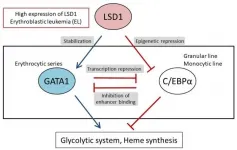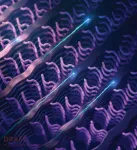(Press-News.org) A research collaboration based in Kumamoto University (Japan) has shown that lysine-specific demethylase 1 (LSD1), an enzyme involved in gene expression, produces individualized metabolism depending on the type of acute myeloid leukemia cells. Cancer cells are known to have a unique ability to metabolize substances differently from normal cells, and this ability is considered to be a promising therapeutic target. The new research findings may contribute to the safe and effective use of LSD1 inhibitors as potential anticancer agents, and to the development of highly specific treatments for various leukemia types.
Acute myelogenous leukemia (AML) occurs when hematopoietic stem cells become tumors rather than differentiating into white or red blood cells. The various types of AML develop according to which stage of differentiation they become cancerous. Those that develop when differentiating into red blood cells are classified as erythroblastic leukemia (EL). Although pathology-specific targeted molecular therapies have been developed for some forms of AML, and have improved treatment outcomes, many forms of the disease, including EL, have high mortality rates due to the lack of individualized therapies. Thus, therapies based on disease type and molecular pathology are desired.
Recent studies have revealed that the inherent metabolic capacity of cancer cells contributes significantly to tumor formation, metastasis and resistance to treatment. Therefore, therapeutic strategies that target nutrient transport and metabolic pathways active in cancer cells have been devised, but it has also been pointed out that metabolic characteristics vary depending on the type and progression of cancer. The metabolic characteristics of AML have not been fully investigated and, in particular, the differences that depend on the disease type and their mechanisms have not been clarified.
Gene expression is regulated by the epigenome. Chemical modifications, such as DNA methylation and methylation of the histone proteins around which the DNA wraps, act as markers to shape the epigenome. There are many differences in the epigenome between cancer cells and normal cells, which in turn generate the differences in gene expression patterns.
Previously, the Kumamoto University research collaboration showed that LSD1, a demethylase that removes methyl groups from methylated histones, is involved in the regulation of energy metabolism in various cell types (Nature Communications 2012, Cancer Research 2015, Nucleic Acids Research 2018). Therefore, they decided to test the possibility that LSD1 is involved in the metabolic regulation of AML cells. Although it has been shown that LSD1 inhibitors may be effective in the treatment of AML, not much is known about the differences in efficacy depending on the disease type. Thus, in this study, the researchers decided to focus on the metabolic differences depending on AML disease type and the role of LSD1.
They first analyzed the gene expression database of AML patients and AML-derived cultured cell lines, and found that both LSD1 and glycolytic genes are highly expressed in EL among AML patients. Then, when they tested the inhibition of LSD1 function using EL cell lines, they found that LSD1 promoted glucose uptake into cells and the glycolytic system. An integrated omics analysis revealed that heme synthesis, a characteristic metabolic pathway of normal red blood cells, is also activated by LSD1. The mechanism was found to be that LSD1 activates glycolytic and heme synthesis gene expression by preventing the degradation of GATA1 protein, an erythroid transcription factor.
Furthermore, under LSD1 functional inhibition, the expression of CEBP/α, a transcription factor of the granulocyte-monocyte lineage of leukocytes, was dramatically up-regulated, inhibiting metabolic regulation by GATA1. These results indicate that LSD1 regulates the balance of transcription factors involved in hematopoietic cell lineage, thereby generating the metabolic phenotype characteristic of EL. Additionally, analysis of clinical data covering various forms of AML showed that the expression of LSD1, GATA1, and glycolytic and heme synthesis genes showed a significant positive correlation. This suggests that regulation of cellular lineage by LSD1 may generate the diversity of metabolic types of AML.
"Based on our research, a combination of LSD1 inhibitors, metabolic target drugs, and conventional therapies may be highly effective in treating patients with EL who express high levels of LSD1," said Associate Professor Shinjiro Hino, who led the study. "It may also be an important clue for selecting patients who may benefit from LSD1 inhibitors in clinical trials."
INFORMATION:
This research was posted online in Blood Advances on 30 April 2021.
Source: Kohrogi, K., Hino, S., Sakamoto, A., Anan, K., Takase, R., Araki, H., ... Nakao, M. (2021). LSD1 defines erythroleukemia metabolism by controlling the lineage-specific transcription factors GATA1 and C/EBPα. Blood Advances, 5(9), 2305-2318. doi:10.1182/bloodadvances.2020003521
Researchers have devised a way to multiply by more than ten-fold the accessible details of gene activity in individual cells. It's a big leap in the effort to understand cancer development, brain function, immunity and other biological processes driven by the complex interactions of multitudes of different cell types.
Organs and tissues are made up of cells that may look the same, but individual cells can actually differ dramatically. Single-cell analysis allows the study of this cell-to-cell variation within an organ, tissue or cancerous tumor. But the research has been hampered by limits on the depth of information that can be gleaned at the single-cell level when working with large numbers of cells.
"The downside has been the low-quality of ...
Most of us are familiar with the fact that women live longer than men. But fellas, if we told you there was one thing that could be done to increase your lifespan, would you do it?
In a study published today in eLife , University of Otago researchers along with collaborators from the United States, have shown that castration of male sheep delays aging of DNA compared to intact males, and that it also drives feminine characteristics of DNA and the chemical tags it holds, known as DNA methylation.
"Both farmers and scientists have known for some time that castrated male sheep live on average much longer than their intact counterparts; however, this is ...
Three mutations in the Epsilon coronavirus spike protein dampen the neutralizing potency of antibodies induced by current vaccines or past COVID infections.
The mutations give this coronavirus variant of concern a means to totally evade specific monoclonal antibodies used in clinics and reduce the effectiveness of antibodies from the plasma of vaccinated people.
To better understand the exact immune escape strategies at work here, the scientists visualized this variant's infection machinery to see what is different from the original configuration of the pandemic coronavirus, and what the implications of these changes are.
The international project was led by David Veesler's lab in the Department of Biochemistry at the University of Washington ...
In a retrospective, multi-centre cohort study conducted by researchers from Nanjing University, Huazhong University of Science and Technology, Jinling Hospital and the Second Hospital of Nanjing, a microRNA-like small RNA encoded by SARS-CoV-2 was identified in the serum of COVID-19 patients, which can be developed as a non-invasive biomarker for stratification of severe patients from mild/moderate ones and for identification of high-risk individuals before clinical manifestation of severe symptoms. This biomarker ensures proper allocation of patients to different ...
A research team, led by Professor Dai-Sik Kim in the Department of Physics at UNIST has developed a new technique of predefining the crack pattern on a flexible substrate by a sequential deposition of metallic layers which leads to a formation of a "zero-nanometer gap, or a "zerogap," between the adjacent lateral patterns.
These gaps, according to the research team, readily open and recover with gentle bending and relaxing of the flexible substrate, precisely along the rims of the pre-patterns of centimeter lengths. Furthermore, in a prototypical pattern of densely packed slit arrays, these gaps serve as antennas achieving transparency for polarizations perpendicular to the length of the gap when opened ...
Chemical elements make up pretty much everything in the physical world. As of 2016, we know of 118 elements, all of which can be found categorized in the famous periodic table that hangs in every chemistry lab and classroom.
Each element in the periodic table appears as a one-, two-letter abbreviation (e.g. O for oxygen, Al for aluminum) along with its atomic number, which shows how many protons there are in the element's nucleus. The number of protons is enormously important, as it also determines how many electrons orbit the nucleus, which essentially makes the element what it is and gives it its chemical properties. In short, the atomic number is an element's ID card.
The periodic table ...
A new organic (carbon-based) semiconducting material has been developed that outperforms existing options for building the next generation of biosensors. An international research team led by KAUST is the first to overcome some critical challenges in developing this polymer.
Much research effort is currently expended into novel types of biosensors that interact directly with the body to detect key biochemicals and serve as indicators of health and disease.
"For a sensor to be compatible with the body, we need to use soft organic materials with ...
Networks of ground-based sensors paired with airborne drones could give firefighters a critical edge when battling wildfires, KAUST researchers have found. The sensor/unmanned aerial vehicle (UAV) network could significantly shorten the time taken to detect a wildfire, giving firefighters a better chance to contain the fire before it grows too large to control.
Wildfire detection is currently performed mainly by satellite imaging and remote cameras, but these technologies can be impeded by cloudy weather and fires can grow to a considerable size before they are spotted. With the recent significant global ...
The surprising results of a decade-long investigation by Alessandro Vezzosi and Agnese Sabato provide a strong basis for advancing a project researching Leonardo da Vinci's DNA.
Their extensive study, published by the journal "Human Evolution" (Pontecorboli Editore, Florence), documents with new certainty the continuous male line, from father to son, of the Da Vinci family (later Vinci), from progenitor Michele (born 1331) to grandson Leonardo (6th generation, born 1452) through to today -- 21 generations in all, including five family branches -- and identifies 14 living descendants.
The work fills gaps and corrects errors in previous genealogical research into Leonardo's family, while ...
A new study shows how urbanisation has influenced anthropogenic CO2 and air pollutant emissions across all world regions, by making use of the latest developments in the Emissions Database for Global Atmospheric Research (EDGAR, https://edgar.jrc.ec.europa.eu/) developed by the Joint Research Centre of the European Commission. The results show that by 2015 urban centres were the source of a third of global anthropogenic greenhouse gases, and the majority of air pollutant emissions.
The authors, from institutions in France and Italy, used the EDGAR database to provide a country-to-global ...





